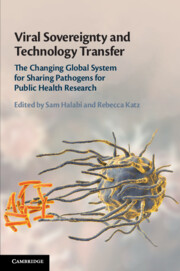 Viral Sovereignty and Technology Transfer
Viral Sovereignty and Technology Transfer Field Capture, Quarantine, and Sample Transfer to Detect Emerging Pathogen Threats
from Part I - The Geopolitical, Historical, and Scientific Context
Published online by Cambridge University Press: 15 May 2020
Chapter 3 explains the process by which researchers identify pathogens ultimately used for public health research. It describes the field capture of animals, clinical sampling of animals and people, analysis for genetic sequencing data, transfer of samples to reference laboratories outside of low- or middle-income countries, and how confirmed infections are reported to public authorities for both public health and sovereign resource reasons. The chapter argues that the process by which researchers now obtain data requires far more bureaucratic barriers, but that correspondingly, researchers are more likely to partner with local scientists and institutions, thus building capacity for disease surveillance and response should an infectious disease threat emerge.
To save this book to your Kindle, first ensure [email protected] is added to your Approved Personal Document E-mail List under your Personal Document Settings on the Manage Your Content and Devices page of your Amazon account. Then enter the ‘name’ part of your Kindle email address below. Find out more about saving to your Kindle.
Note you can select to save to either the @free.kindle.com or @kindle.com variations. ‘@free.kindle.com’ emails are free but can only be saved to your device when it is connected to wi-fi. ‘@kindle.com’ emails can be delivered even when you are not connected to wi-fi, but note that service fees apply.
Find out more about the Kindle Personal Document Service.
To save content items to your account, please confirm that you agree to abide by our usage policies. If this is the first time you use this feature, you will be asked to authorise Cambridge Core to connect with your account. Find out more about saving content to Dropbox.
To save content items to your account, please confirm that you agree to abide by our usage policies. If this is the first time you use this feature, you will be asked to authorise Cambridge Core to connect with your account. Find out more about saving content to Google Drive.